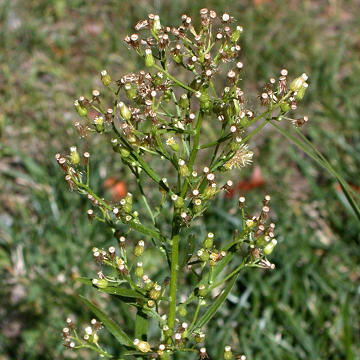

Erigeron canadensis - (image 1 of 4)
Taxonomy
Family: Asteraceae
For many years this species was called Conyza canadensis (L.) Cronq. but has recently been included back in Erigeron.
Habitat
Old fields and disturbed areas.
Associates
Distribution
Throughout the U.S. and southern Canada to tropical America.
Morphology
Herbaceous, taprooted annual or winter annual; stems 10-150 cm, solitary; leaves numerous, pubescent or at least ciliate at the base, oblanceolate to linear, acute, the lower leaves usually toothed, otherwise entire, gradually reduced to the inflorescence; basal leaves larger and broader than the cauline and usually deciduous; heads usually numerous in a long and open inflorescence; involucres 3-4 mm, glabrous or with few scattered hairs; involucral bracts imbricate, brown or with brown or pale midvein and greener margins; rays mostly 25-40, white to pinkish, 0.5-1 mm, equaling to slightly passing the style and pappus.
Notes
Flowers late summer to fall
Wetland indicator: FACW
Another common name is Canada Horseweed. Typically found in weedy situations. Other Erigeron spp. are fibrous-rooted perennials with longer rays (more than 3 mm).
References
Gleason, Henry A.
and A. Cronquist. 1991. Manual of Vascular Plants of Northeastern United States
and Adjacent Canada. Second Ed.
The New York Botanical Garden. Bronx, NY
|
Michael Hough © 2018 |